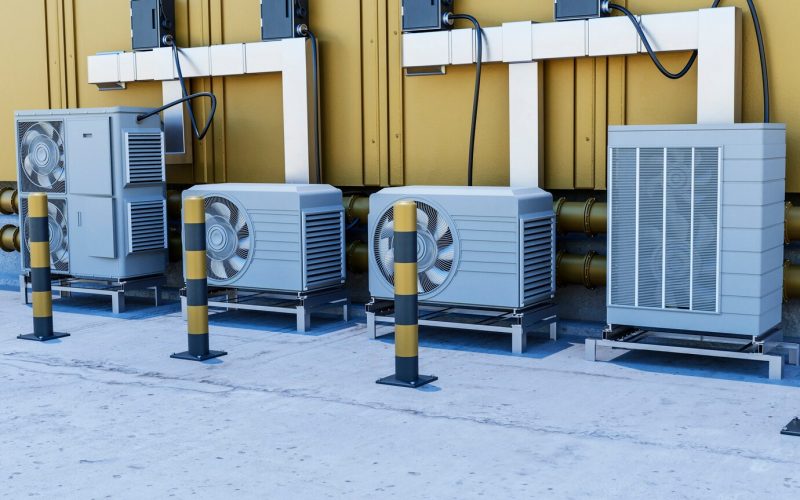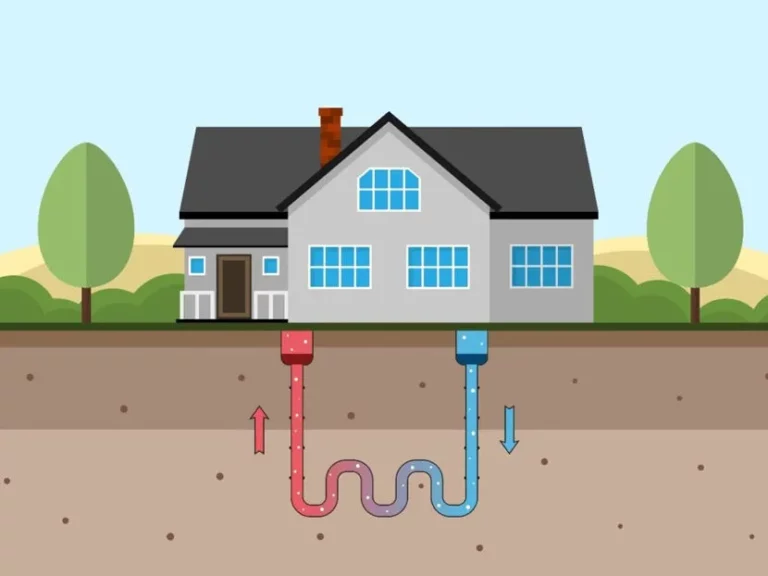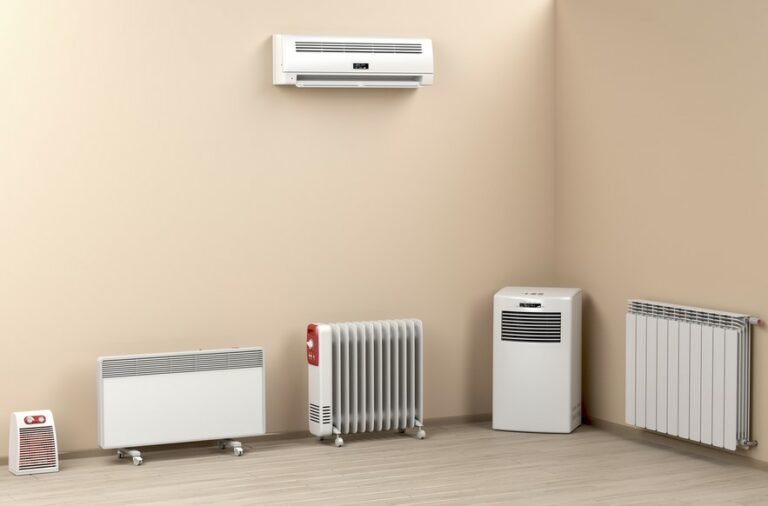Heating, ventilation, and air conditioning (HVAC) systems warm indoor spaces in the winter and cool them in the summer. In addition to your air conditioner and furnace, HVAC includes combined systems like heat pumps and indoor air-quality equipment like air purifiers. It also encompasses the control systems and smart thermostats that help everything work together.
HVAC stands for heating, ventilation, and air conditioning. It refers to the systems that regulate and move heated and cooled air throughout residential and commercial buildings, from homes to offices to indoor stadiums. Although there are many options when it comes to HVAC systems, they all work similarly: taking in fresh air and using a mechanical ventilation system to heat or cool it to a desired temperature.
HVAC units also can control humidity levels and improve air quality through air cleaners that capture bacteria, spores, and virus-sized particles. The HVAC technician who comes to your home for a pre-installation evaluation will help you determine which system and options are best for you and your home.
At the most basic level, an HVAC system takes in air, cools or heats that air, and blows it into an indoor space, according to the American Society of Heating, Refrigerating and Air-Conditioning Engineers. That space could be a specific room or an entire building or structure, such as a house, office, school, airport, or even a submarine. An individual component of an HVAC system may serve dual purposes. For example, your home could have a separate air conditioner and furnace, or a heat pump for both cooling and heating.
In addition to moving air and making it comfortable inside, HVAC systems can improve the air by drawing it through filters that remove dust, particles, spores, bacteria, and viruses, says Rick Bohdel with Ductz. Whole-home humidifiers and dehumidifiers can add or remove humidity to keep the dew point of your home at an ideal level. This can make your home feel cooler without having to run a cooling system.
All of these components link to a conventional or internet-connected (smart) thermostat. Depending on the sophistication of your control system, you may be able to program your HVAC equipment through an app to make small changes that help each component run at its peak. Smart thermostats can also reduce the overall costs of heating and cooling your home because they help maintain the temperature within a designated range.
HVAC systems are designed to move air, heating or cooling an indoor space in the process. These systems generally have three major elements: a heating unit, a cooling unit, and ducts to move the air. Bright Hub Engineering explains that an HVAC system starts with the ventilation that brings fresh air into a building. Natural ventilation takes air from open windows, doors, or cracks and uses pressure differences to force the air through a building. With today’s tightly sealed homes and offices, this requires the use of fans, blowers, filters, and ducts.
Air Conditioning Systems
HVAC systems also have a cooling unit, usually an AC unit. To cool air, the fan in an air conditioning unit from Frigidaire, Coleman, and other HVAC companies draws the air in and forces it over the evaporator’s coils. Filled with refrigerant, these coils draw heat from the air, cooling it. Next, the air moves into the air handler, where a blower sends it into the ducts. As the cool air moves through the ducts, any noxious gasses produced during the process are expelled through the flue.
When an air conditioner absorbs heat, the refrigerant vaporizes. To return to its natural state, the refrigerant travels into the compressor, which pressurizes it, and onto the condenser, where it condenses from a vapour back into a liquid. As it does, it expels heat that is blown out by a fan.
In some areas where it doesn’t get cold enough for a furnace, a heat pump that can both cool and heat the air is a cheaper option. Either way, these units’ cooling efficiency is measured by their Seasonal Energy Efficiency Ratio (SEER), and the cool air they produce is distributed into the house through the ductwork. For energy efficiency, you want to shop for a unit with a high SEER rating. The highest efficiency units will have SEER ratings of 20 or more, while the minimum rating is 13. To receive the U.S. government’s Energy Star certification, an air conditioner must have a SEER of at least 14.
Heat Pumps
A heat pump works similarly to a central air conditioner and is based on the idea that heat is always attracted to cold. To cool the air, heat is absorbed by the refrigerant and expelled out of the building. To produce warm air, a heat pump draws cold outside air over even colder refrigerant. Heat is then drawn into the refrigerant, which heats the coils. The air is drawn over those heated coils, where it rises to the desired temperature and is blown into the home.
Furnaces
To heat a building using a gas furnace, an HVAC system draws air in through the ducts and forces it into the furnace, according to HVAC dealer Ingram’s Water & Air Equipment. When the furnace is running, the combustion chamber heats the heat exchanger to the designed temperature. Air is pushed through the exchanger, heated, and blown by the motor through the ducts and back into the house.
An oil furnace like those sold by American Standard works similarly. An oil furnace pumps oil from a reserve tank through a filter and into a chamber, where it’s converted into a mist and sprayed on a burner. The burner ignites, and the flame heats the heat exchanger. Just as it is with a gas furnace, the air is then forced into the exchanger, heated, and blown back into the house. Oil furnaces are rare; Richmond’s Air Heating & Air Conditioning says that only 5% of all HVAC systems use them.
Some gas furnaces from York, Amana, and other companies can be modified to burn liquid propane instead of natural gas or oil. Propane furnaces are a good option for remote areas where other fuel sources might not be as reliable. Additionally, propane furnaces can fit in mechanical closets and other small spaces when square footage is scarce.
Whether the furnace runs on natural gas, electricity, or propane, its efficiency is measured by its Annual Fuel Utilization Efficiency (AFUE) rating, which indicates how much fuel is converted into heat. A furnace with an AFUE rating of 95% converts 95% of the fuel supplied to it into heat. Today, the minimum acceptable AFUE rating is 80%. Particularly high-efficiency models like those from Carrier, Bryant, and Goodman have ratings of 95% to 98%.
Ventilation and Thermostats
Some systems may also include ventilation systems that direct air out of the house, humidifiers (or dehumidifiers) that adjust the air’s humidity, and air purifiers that filter out spores, bacteria, viruses, and other minuscule particles. An HVAC tech can help you determine which of these additional components, if any, make sense for your needs.
All of these are controlled by a conventional or smart thermostat like those sold by Lennox, Trane, and Rheem. When the temperature or other criteria reach a set point, it triggers the necessary components to begin running. Some smart systems can even alert you to a problem, remind you to change the filters, and share diagnostics with your HVAC contractor.
There are several types of HVAC systems to choose from, each designed for different environments and needs. When deciding on the type of HVAC you need, some factors to consider include your heating and cooling needs, where your home is located, its age, and any existing ductwork. Your HVAC technician can also help you determine the type of system that will best meet your needs.
Here are the types of HVAC systems available and how they work to help guide your search:
Split System System
Also referred to as a forced-air system, a split system has one unit inside the home and one outside. This setup can consist of a furnace and air conditioner, an air handler and heat pump, or a furnace and heat pump. Which configuration is best for your home will depend largely on where you live. For example, the furnace and heat pump setup works best in very cold climates.
Hybrid Heat Pump System
In this scenario, the central heating system includes an electric heat pump that works in conjunction with a furnace. In milder times of the year like the spring and fall, the heat pump heats the home. During weather that’s too cold for a heat pump to operate effectively, the furnace takes over. This hybrid system, also known as a dual-fuel system, saves money because it costs less to heat the home with a heat pump than a furnace.
Ductless Mini-Split System
A ductless mini-split system has an outdoor unit that contains the compressor and condenser, and an indoor air handler mounted in the room that blows the cooled air directly into the room, according to the Air Conditioning, Heating & Refrigeration Institute. This type of ductless system is usually best for small spaces, such as garages and workshops, that don’t require a traditional split system, but they aren’t suitable for whole-house applications. Typically, these systems are simple enough for homeowners to install themselves.
Ducted Mini-Split System
A ducted mini-split system uses tubes instead of larger ducts to move air into a room from an outdoor compressor and condenser. This solution is best for homes where there isn’t a lot of room for traditional ductwork. Compared to ductless mini-split systems, ducted mini-splits have the advantage of better air circulation.
Packaged System
A packaged system contains the traditional components of a split system, but all units are housed outside. This works best for homes that don’t have the space for a heating unit inside. But even if you do have the space for a split system, you might consider a packaged system because they’re quieter, since everything is located outside, and have lower installation costs. After all, there’s only one unit to install.
DIY installing a full HVAC system is a big task. It’s possible if you’re handy, have some experience, and have done your homework, but we don’t recommend it. Your local government may also require you to hire a licensed professional. While you can self-install a window AC unit easily enough, it takes extra knowledge to replace an entire furnace and/or central air conditioner.
The steps vary based on the type of system you’re installing, but detailed planning will be involved no matter what. HVAC installation for a split system, for example, involves tasks like hooking up refrigerant lines, charging the system, cleaning and sealing ducts (assuming central ductwork is already in place), correctly venting the furnace, ensuring condensate lines drain properly, and making sure electrical hookups conform to code. A new ductless mini-split, on the other hand, will require you to mount the indoor air handler on the wall, run refrigeration conduits, and install the outdoor unit. If you’re removing old refrigerant, you’ll need to be certified by the Environmental Protection Agency (EPA) to do so.
While it may seem like you can save money by going the DIY route, improper HVAC installation can lead to further issues and require another repair or replacement in the future. Self-installation takes time and effort, and it can also lead to injuries like electric shock or cause dangerous situations like gas leaks, so know the risks before you choose to do it yourself. Make sure you’re aware of the necessary permits and codes for your area, too.
Tips for Finding a Contractor
- Make sure they’re licensed and insured. State licenses require technicians to know local codes and be experts in safety, service, and installation. They should also be able to pull permits.
- See if they have any certifications. For example, many contractors are certified through North American Technician Excellence (NATE).
- Check reviews. Scroll through local consumer sites to see if there are trends in reviews or complaints, like technician tardiness or dissatisfaction with the quality of the job.
- Ask for references. Call these references and ask if the contractor was timely and the work was satisfactory.
- Review available equipment. If you’re looking for a particular brand of equipment, make sure the contractor you hire carries it.
- Get an in-person quote. A technician should be able to come to your home, take measurements, and give recommendations specific to your situation.
- Compare costs and warranties. The cheapest isn’t always the best. You might save money by going with the more affordable equipment, but if it breaks and the warranty doesn’t cover it, you’ll end up paying more.
- Get itemized proposals in writing. What exactly does the job entail? What will the contractor repair or replace and how much does each item cost, plus labor? What brands does the contractor carry?
Tips for Choosing an Equipment Brand
We’ve rated the top HVAC companies, so check out our guide to get started comparing different brands and their features. As you consider each company, you should also:
- Ask your contractor what they carry. Most contractors only carry or deal in certain brands of equipment, while few might install a system you’ve already purchased.
- Look at energy efficiency and sound ratings. The higher the SEER rating, the better the efficiency. Also, check for Energy Star-qualified systems. For sound ratings, outdoor units can have louder decibel levels than indoor units.
- Assess size. Make sure an HVAC system aligns with the load requirements of your home. Have the contractor measure square footage to determine BTU and tonnage requirements.
- Review maintenance requirements. How often will you need to service the equipment, check refrigerant levels, clean components, and change filters?
- Check fuel sources. If your home has gas lines, for example, you might choose a gas furnace. Other fuel sources include electricity, propane, heating oil, and geothermal.
- Weigh the potential costs. Check out our guide on Central Air Costs and Ways To Save Money for more information.
HVAC and air conditioning are often used interchangeably, but the terms refer to two different things. An HVAC system consists of several components that work together to regulate the temperature and ventilation in a building, while air conditioners only cool the building. HVAC systems can include an air conditioner among their components, but a central air conditioner consists of just an air conditioner. Air conditioners fall under the HVAC umbrella, but not all HVAC systems include an air conditioner.
source: usnews





